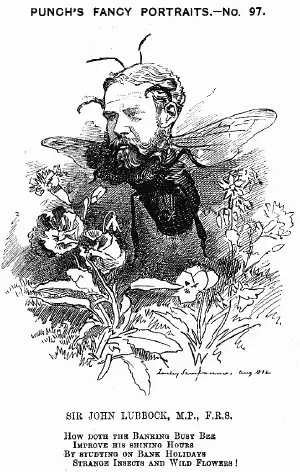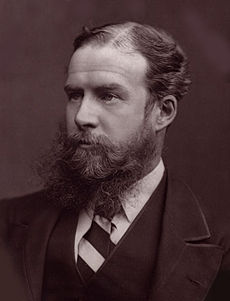John Lubbock, 1st Baron Avebury
|
John Lubbock | |
|---|---|
| File:John Lubbock.jpg John Lubbock | |
| Born |
30 April 1834 |
| Died | 28 May 1913 |
| Nationality | English |
| Field | Finance, Biology, Archaeology, Politics |
| Known for | Bank Holidays |
| Influences | Charles Darwin |
Sir John Lubbock, 4th Baronet, 1st Baron Avebury, PC FRS (30 April 1834 – 28 May 1913), English banker, politician, biologist and archaeologist was born the son of Sir John William Lubbock, Bart.
Life
Lubbock was educated at Eton College from 1845 and afterwards was taken into his father's bank (which later amalgamated with Coutts & Co), where he became a partner at the age of twenty-two. In 1865 he succeeded to the baronetcy.
In 1870, and again in 1874, he was elected as a Liberal Party Member of Parliament (MP) for Maidstone. He lost the seat at the election of 1880; but was at once elected member for the University of London, of which he had been vice-chancellor since 1872. He carried numerous enactments in parliament, including the Bank Holidays Act of 1871 and the Ancient Monuments Act of 1882. When the Liberals split in 1886 over Irish Home Rule, Lubbock joined the breakaway Liberal Unionist Party.
Lubbock was elected the first president of the Institute of Bankers in 1879; in 1881 he was president of the British Association, and from 1881 to 1886 president of the Linnean Society of London. In March 1883 he founded the Bank Clerks Orphanage, which in 1986 became the Bankers Benevolent Fund - a charity for bank employees, past and present and their dependants. In January 1884 he founded the Proportional Representation Society, later to become the Electoral Reform Society.
In 1865 Lubbock published what was probably the most influential archaeological text book of the 19th Century, Pre-historic Times, as Illustrated by Ancient Remains, and the Manners and Customs of Modern Savages, and was responsible for inventing the names Palaeolithic and Neolithic to denote the Old and New Stone Ages respectively.
Lubbock was also an amateur biologist of some distinction, writing books on hymenoptera (Ants, Bees, and Wasps. A Record of Observations on the Habits of the Social Hymenoptera.New York: Appleton, 1884.), on insect sense organs and development, on the intelligence of animals, and on other natural history topics. He was a member of the famous X Club founded by T.H. Huxley to promote the growth of science in Britain. He discovered that ants were sensitive to the ultraviolet range of the spectrum.[1][2] The Punch verse of 1882 captured him perfectly:
- How doth the Banking Busy Bee
- Improve his shining Hours?
- By studying on Bank Holidays
- Strange insects and Wild Flowers!
He carried out extensive correspondence with Charles Darwin, who was his neighbor in Downe except for a brief period 1861-1865, when Lubbock moved to Chislehurst. He first leased and then sold to Darwin the land on which the latter's famed Sand Walk was made. He helped engineer Darwin's burial in Westminster Abbey following the latter's death in 1882.
Lubbock received honorary degrees from the universities of Oxford, Cambridge (where he was Rede lecturer in 1886), Edinburgh, Dublin, and Wurzburg; and in 1878 was appointed a trustee of the British Museum. From 1888 to 1892 he was president of the London Chamber of Commerce; from 1889 to 1890 vice-chairman and from 1890 to 1892 chairman of the London County Council.
In February 1890 he was appointed a privy councillor[3]; and was chairman of the committee of design on the new coinage in 1891. In January 1900 he was raised to the peerage, under the title of Baron Avebury.
Trivia
The quotation "We may sit in our library and yet be in all quarters of the earth" is widely attributed to Lubbock. This variation appears in his book The Pleasures of Life: "Not only does a library contain "infinite riches in a little room," but we may sit at home and yet be in all quarters of the earth."
Footnotes
- ↑ Lubbock, J. (1881). Observations on ants, bees, and wasps. IX. Color of flowers as an attraction to bees: Experiments and considerations thereon.. J. Linn. Soc. Lond. (Zool.) 16: 110–112.
- ↑ Kevan, Peter G. and Chittka, Lars & Dyer, Adrian G. (2001). Limits to the salience of ultraviolet: lessons from colour vision in bees and birds. J. Exp. Biol. 204: 2571-2580.
- ↑ London Gazette issue 26022 11 february 1890
ReferencesISBN links support NWE through referral fees
- Hutchinson, H.G., 1914, Life of Sir John Lubbock, Lord Avebury. London.
- Grant Duff, U., 1924, The life-work of Lord Avebury. London: Watts & Co.
- Sir John.Lubbock in The Columbia Encyclopedia (Sixth Edition, 2001)
- Lubbock, J., 1865, Pre-historic times, as illustrated by ancient remains, and the manners and customs of modern savages. London: Williams and Norgate.
- Trigger, B.G., 1989, A history of archaeological thought. Cambridge: Cambridge University Press.
- This article incorporates text from the Encyclopædia Britannica Eleventh Edition, a publication now in the public domain.
- Lubbock, J., 1887-89, The pleasures of life
- Patton, M. 1997, Science, politics & business in the work of Sir John Lubbock - a man of universal mind. London, Ashgate.
External links
- Obituary
- Electoral Reform Society
- Wikiquote
- Works by John Lubbock. Project Gutenberg
- Lubbock, J., Addresses, Political and Educational (1879)
- Lubbock, J., Monograph of the Collembola and Thysanura (1879)
- John Lubbock at Minnesota State University eMuseum
- John Lubbock at bartleby.com
- Lubbock, J. Pre-historic times: as illustrated by ancient remains and the manners and customs of modern savages (1900)
| Parliament of the United Kingdom | ||
|---|---|---|
| Preceded by: Charles Buxton and James Whatman |
Member of Parliament for Maidstone with James Whatman, 1865–1874; Sir Sydney Waterlow, 1874–1880 1870–1880 |
Succeeded by: Alexander Henry Ross and John Evans Freke-Aylmer |
| Preceded by: Robert Lowe |
Member of Parliament for London University 1880–1900 |
Succeeded by: Sir Michael Foster |
| Academic offices | ||
| Preceded by: Andrew Carnegie |
Rector of the University of St Andrews 1907–1910 |
Succeeded by: The Earl of Rosebery |
| Baronetage of the United Kingdom
| ||
| Preceded by: John Lubbock |
Baronet (of Lammas) 1865–1913 |
Succeeded by: John Lubbock |
| Peerage of the United Kingdom
| ||
| Preceded by: (new creation) |
Baron Avebury 1900–1913 |
Succeeded by: John Lubbock |
Credits
New World Encyclopedia writers and editors rewrote and completed the Wikipedia article in accordance with New World Encyclopedia standards. This article abides by terms of the Creative Commons CC-by-sa 3.0 License (CC-by-sa), which may be used and disseminated with proper attribution. Credit is due under the terms of this license that can reference both the New World Encyclopedia contributors and the selfless volunteer contributors of the Wikimedia Foundation. To cite this article click here for a list of acceptable citing formats.The history of earlier contributions by wikipedians is accessible to researchers here:
The history of this article since it was imported to New World Encyclopedia:
Note: Some restrictions may apply to use of individual images which are separately licensed.

